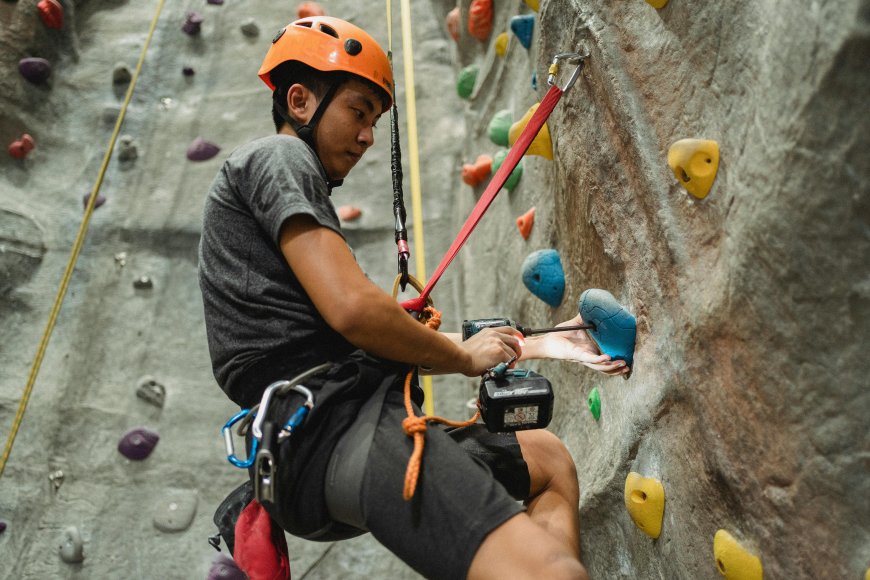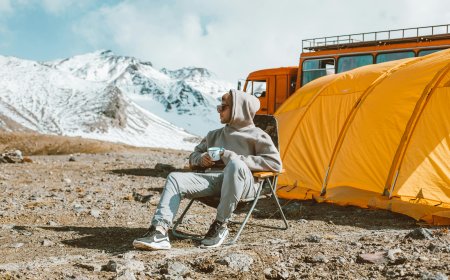How to choose the best mountain climbing equipment?
Choosing the best mountain climbing equipment requires attention to detail and a careful assessment of your needs and potential trip conditions. Look for high-quality and durable mountain climbing gear, with a focus on lightweight and suitability for changing weather conditions. Ensure you select equipment that is compatible with your level of experience and climbing skills, focusing on providing safety and optimal performance on every climbing adventure.

Choosing the best mountain climbing equipment requires attention to detail and a careful assessment of your needs and potential trip conditions. Look for high-quality and durable mountain climbing gear, with a focus on lightweight and suitability for changing weather conditions. Ensure you select equipment that is compatible with your level of experience and climbing skills, focusing on providing safety and optimal performance on every climbing adventure.
How to choose the best mountain climbing equipment?
A comprehensive guide to choosing the best mountain climbing equipment requires considering several important aspects to ensure safety and optimal performance during climbing trips
1. Prioritize Safety
Safety should be paramount when selecting mountain climbing equipment. Ensure you choose certified gear that complies with international safety standards.
2. Material Quality and Manufacturing
Look for equipment made from high-quality and durable materials such as aluminum and stainless steel. Check the manufacturing and fine details to ensure the strength and durability of the equipment.
3. Fit and Comfort
Equipment should fit comfortably and suit your climbing style. Ensure that gloves, shoes, and clothing fit your size and provide comfort during climbing.
4. Lightweight and Portability
Try to choose lightweight and easily transportable equipment, especially if you're planning long trips or multi-stage climbs. Excess weight may negatively affect your performance and endurance.
5. Adaptability to Weather Conditions
Select versatile equipment suitable for various weather conditions such as rain, snow, and strong winds. Ensure that the equipment protects you and provides warmth in harsh conditions.
6. Compatibility with Experience Level
Evaluate your climbing skills and experience level, and choose equipment that suits your level. You may need advanced equipment if you consider yourself a professional climber.
7. Invest in Training and Knowledge
Train and acquire knowledge on how to use the equipment correctly and effectively. Proper preparation and good training can make a significant difference in your climbing experience.
By carefully selecting mountain climbing equipment and following these tips, you can enjoy climbing trips with maximum safety, comfort, and confidence.
How to choose suitable mountain climbing equipment for each level
Determining the appropriate equipment for each level of climbing depends on several factors, including your skills, experience, and the goals you aim to achieve on your climbing trips. I'll explain how to choose suitable equipment for each level
1. For Beginners
- Start by purchasing essential gear like a climbing harness, climbing helmet, and a suitable length climbing rope.
- Look for user-friendly equipment that provides basic safety during climbing.
- Seek advice from professionals or trainers for insights on prioritizing equipment selection and proper usage.
2. For Intermediates
- Look for more advanced equipment such as belay devices, carabiners, and climbing cams for rock climbing.
- Upgrade your basic gear for increased comfort and safety, such as buying a harness with the most comfortable design or a climbing helmet that offers better protection.
- Invest in additional equipment that meets your individual needs and enhances your climbing performance.
3. For Professionals
- Choose high-quality mountain climbing equipment that aligns with advanced climbing challenges.
- Invest in advanced electronic navigation devices that provide accurate readings of altitude, speed, and direction.
- Purchase multi-purpose climbing ropes that withstand heavy loads and provide sufficient safety for climbing in challenging conditions.
- Explore modern climbing techniques like advanced anchoring tools that provide additional stability and safety.
By selecting mountain climbing equipment that suits your level and experience, you'll be able to improve your performance and enjoy climbing experiences better while maintaining safety and comfort on every journey.
Basics of choosing the appropriate mountain climbing equipment successfully
Identifying the appropriate equipment for successful mountain climbing requires consideration of several key factors that impact your performance and safety during climbing. I'll provide details about the essentials of choosing suitable mountain climbing equipment
1. Harness and Basic Gear
- The harness is one of the most crucial pieces of climbing equipment, distributing weight evenly and providing a tie-in point for the rope.
- Ensure you choose a harness that fits you well and provides comfort during long periods of climbing.
2. Climbing Helmet
- A climbing helmet is essential for protecting the head from falling rocks and incidental falls.
- Choose a durable and lightweight helmet that fits well to provide necessary protection.
3. Shoes
- The right shoes play a crucial role in stability and control during climbing.
- Choose shoes specifically designed for mountain climbing, known for stability, comfort, and good support.
4. Ropes
- Ropes are an essential part of climbing equipment and should be chosen carefully.
- Select durable and strong ropes designed to withstand tension and tearing, providing you with good control during climbing.
5. Anchoring and Assistance Tools
- Anchoring tools like carabiners and cams help provide additional anchor points during climbing.
- Choose appropriate anchoring tools for the terrain you'll be climbing and anticipate needing.
6. Clothing and Personal Gear
- Select appropriate climbing attire that suits weather conditions, providing comfort and protection.
- Don't forget your personal gear such as gloves, sunglasses, and a backpack for carrying additional equipment.
By successfully choosing the right mountain climbing equipment, you'll be able to enjoy climbing experiences safely and confidently, while providing the necessary comfort for every climbing trip.
Choosing mountain climbing equipment gives you confidence on every trip
Choosing mountain climbing equipment that instills confidence in every trip requires attention to detail and thorough verification of equipment quality. Here are the tedious details on how to choose mountain climbing equipment that ensures confidence on every journey
1. Quality and Durability
- Check the quality of materials used in manufacturing the equipment, ensuring durability and strength to withstand harsh mountain conditions.
- Look for equipment bearing quality marks and recognized industry standards, such as trusted brands.
2. Safety and Reliability
- Ensure that the equipment provides necessary protection in emergencies like falls or slips.
- Choose equipment that comes with safety and performance guarantees, with additional features to enhance safety such as extra straps and double buckles.
3. Fit and Comfort
- Ensure that the equipment fits your body and provides comfort during long climbs.
- Choose equipment that offers perfect fit and even weight distribution to avoid feeling strained or fatigued during climbing.
4. Lightweight and Portability
- Choose lightweight and easily portable equipment, especially if you plan long or multi-day trips.
- Ensure that the equipment comes with bags or carriers that facilitate transportation and mobility in the mountains.
5. Compatibility with Skills and Experience
- Select equipment that aligns with your skill level and climbing experience, providing the necessary control and stability for each level.
- Ensure that you understand how to properly use the equipment and that it meets your needs and goals in climbing.
6. Training and Knowledge
- Read equipment reviews and user opinions to gain a better understanding of equipment performance in real-world scenarios.
- Invest in training on how to use the equipment correctly and effectively to increase confidence and performance on every trip.
By choosing equipment that gives you confidence on every journey, you'll be able to climb with confidence, safety, and comfort, making it easier to enjoy your nature experience and explore the mountains safely.
How to Avoid Common Mistakes in Choosing Mountain Climbing Equipment
Avoiding common mistakes in choosing mountain climbing equipment requires attention to detail and checking several factors to ensure selecting the right gear. Here are details on how to avoid these mistakes
1. Not Matching Equipment with Experience Level
- Mistake: Buying overly advanced equipment for beginners or simplistic gear for professionals.
- Solution: Choose equipment that aligns with your experience level and climbing skills, focusing on safety and comfort.
2. Ignoring Quality and Durability
- Mistake: Purchasing cheap equipment without verifying its quality and durability.
- Solution: Ensure the quality of materials used in manufacturing the equipment and check user reviews to ensure reliable performance.
3. Neglecting Fit and Comfort
- Mistake: Buying equipment that doesn't fit your body or provide comfort during climbing.
- Solution: Choose equipment that fits your body and provides comfort during climbing, paying attention to details like ventilation and organization.
4. Overlooking Environmental and Weather Requirements
- Mistake: Not selecting suitable equipment for the environmental and weather conditions you'll encounter on your trip.
- Solution: Choose equipment suitable for expected weather conditions, considering factors like water, snow, and strong winds.
5. Ignoring Personal Testing and Evaluation
- Mistake: Buying equipment without testing or evaluating it yourself.
- Solution: Visit specialized stores, test the equipment yourself, and speak with professionals and users for guidance and advice.
6. Not Investing in Training and Learning
- Mistake: Not investing in training on how to use equipment correctly.
- Solution: Train on how to use the equipment and gain knowledge about safe and effective climbing techniques, focusing on appropriate techniques and tactics for your experience level.
By avoiding these common mistakes, you can choose the right equipment that instills confidence in every climbing trip, making it easier to achieve your goals and enjoy climbing experiences safely and comfortably.
Mountain climbing equipment that suits your goals and skills
When choosing mountain climbing equipment that suits your goals and skills, you should consider several important factors to ensure maximum safety, comfort, and performance. Here are details on how to choose mountain climbing equipment that fits your goals and skills
1. Define your climbing goals
- Before selecting equipment, identify your climbing goals such as rock climbing, ice climbing, or mountaineering.
2. Evaluate your skill level
- Assess your climbing skills and experience level, whether you're a beginner, intermediate, or advanced climber, to determine the appropriate equipment.
3. Identify areas you want to explore
- Research the areas you plan to visit and climb, and benefit from the experiences of climbers who have visited them before to identify the suitable equipment.
4. Consult specialists and professionals
- Benefit from the experiences of expert climbers and consult professionals at climbing gear stores for advice and guidance on suitable equipment.
5. Choose equipment according to your goals and skills
- Select equipment that aligns with your goals and skills, considering safety, comfort, and performance in the environments you intend to climb in.
6. Try out equipment before purchasing
- Before making a purchase, try out the equipment at a climbing store or at least inquire about the return and exchange policy to ensure you can test and evaluate the equipment before making a buying decision.
7. Update equipment based on skill development
- Continuously update your equipment to match the development of your skills and experience in climbing, and take advantage of new technologies and innovations available in the market.
By choosing mountain climbing equipment that suits your goals and skills, you'll be able to enjoy climbing experiences with confidence and comfort, helping you achieve success in your climbing adventures.
Advanced mountain climbing equipment
Advanced mountain climbing equipment represents a revolutionary leap in climbing technology, providing advanced tools that enhance performance and safety during climbing in harsh mountain environments. Let's delve into the details of some advanced climbing equipment
1. Advanced dynamic climbing ropes
- Advanced dynamic climbing ropes are designed to withstand shocks and heavy weights while maintaining high flexibility.
- They feature advanced technologies such as anti-corrosion coatings and stretch-resistant techniques to improve performance and ensure safety.
2. Electronic navigation devices
- Electronic navigation devices provide precise readings of altitude, speed, direction, and even temperature.
- They rely on modern technology such as GPS devices and compasses to provide climbers with accurate and reliable information.
3. Advanced anchoring tools
- Advanced anchoring tools include pitons and flat plates designed with advanced techniques to provide stability and safety during climbing.
- They feature innovative designs that provide additional stability and reduce pressure on rocks and soil.
4. Advanced climbing shoes
- Advanced climbing shoes feature advanced technologies that provide stability and grip during climbing, while maintaining comfort and flexibility.
- They include technologies such as specially designed rubber soles for better rock adhesion and grip.
5. Technical climbing clothing
- Technical climbing clothing features ventilation and advanced fabric technologies that provide comfort and protection in changing climbing conditions.
- They include features such as moisture-wicking and protection from harsh weather elements to keep the body dry and warm.
6. Advanced rescue and emergency devices
- Advanced rescue and emergency devices include technologies such as fall detection alarms and electronic communication devices for emergency situations.
- They are designed to assist in survival and provide assistance in emergency situations on the mountain.
By using advanced mountain climbing equipment, climbers can enhance their performance and increase safety levels during climbing in challenging mountain environments. These equipment innovations support both amateurs and professionals alike in successfully and confidently tackling climbing challenges.
Summary
Choosing the best mountain climbing equipment requires careful analysis of climbing requirements and the surrounding environment. It's important to seek equipment that combines quality, performance, and safety to ensure a successful and fruitful climbing experience. In this context, selecting advanced equipment that matches the climber's level of experience and skills, while considering weather conditions and terrain complexities, is essential. Key factors in equipment selection include comfort and fit, reliability and safety, as well as advanced technologies and modern innovations. Climbers should be cautious and deliberate in choosing equipment that provides sufficient protection and enhances their performance on every climbing trip. Therefore, selecting the right equipment contributes to boosting confidence and assurance during climbing, making it easier for climbers to achieve their goals with confidence and safety.
Sources
1. REI (Recreational Equipment, Inc.) Website
- The REI website offers comprehensive articles and resources on selecting mountain climbing equipment.
2. OutdoorGearLab Website
- OutdoorGearLab provides objective comparisons and reviews of climbing gear based on practical experiences and tests.
3. Climbing Magazine Website
- Climbing Magazine offers articles and resources on techniques and strategies for selecting mountain climbing equipment.
What's Your Reaction?



































































































































































